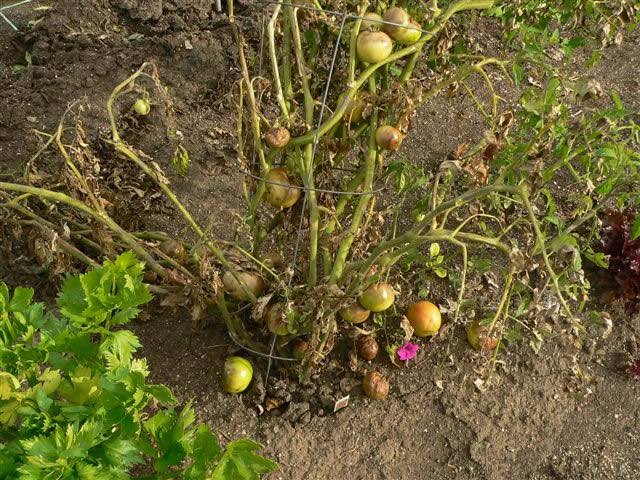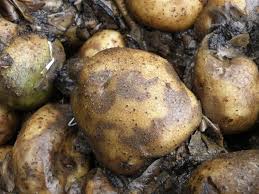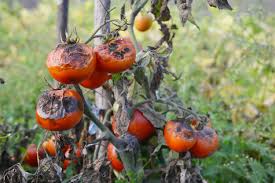Late blight, scientifically known as Phytophthora infestans, is a plant disease that affects potatoes and tomatoes and this destructive pathogen can cause significant damage to crops, leading to economic losses and impacting food security.
Late blight is caused by a water mold, a type of oomycete, which thrives in cool, moist conditions. The disease is notorious for its rapid spread, often facilitated by wind-driven rain and humid environments. It poses a serious threat to potato and tomato crops worldwide, making it a key concern for farmers and agricultural experts.
The first signs of late blight are usually observed as dark lesions on the leaves, often accompanied by a white, fuzzy growth. These lesions can quickly expand and cover large areas of the plant, leading to the wilting and death of affected tissues. Infected potato tubers and tomato fruits may also exhibit symptoms, manifesting as dark, sunken spots that render them inedible.
The economic impact of late blight is substantial, as it can devastate entire fields of potatoes and tomatoes. Crop losses can result in reduced income for farmers and higher prices for consumers due to decreased supply. Additionally, the costs associated with implementing control measures, such as fungicides and crop rotation, add to the financial burden on the agricultural industry.
Farmers often face the challenge of managing late blight through integrated pest management strategies. These may include the use of resistant potato and tomato varieties, employing cultural practices like spacing and pruning to enhance air circulation, and applying fungicides to control the spread of the pathogen.
One of the notable historical events related to late blight is the Irish Potato Famine in the mid-19th century. The disease played a significant role in causing widespread crop failures, leading to a devastating famine that had severe consequences for the Irish population.
Scientific research continues to be crucial in understanding the biology of Phytophthora infestans and developing effective strategies for late blight management. Genetic studies aim to identify resistance genes in both crops, offering potential solutions for breeding resistant varieties that can withstand the onslaught of this destructive pathogen.
However, late blight poses a serious threat to potato and tomato crops globally, with the potential for devastating economic and food security consequences. Ongoing efforts in research and agricultural practices are essential to mitigate the impact of this disease and ensure the sustainable production of these important food crops.
Read Also: The History and Origin of Burmese Pythons
Plants Affected by Late Blight (Phytophthora infestans)

Late blight primarily affects two important food crops: potatoes (Solanum tuberosum) and tomatoes (Solanum lycopersicum). These plants belong to the Solanaceae family and are susceptible to the destructive impact of the Phytophthora infestans pathogen.
Potatoes, grown for their starchy tubers, are particularly vulnerable to late blight. The disease can quickly spread through a potato field, causing dark lesions on the leaves and affecting the tubers beneath the soil. Infected tubers may develop dark, sunken spots, rendering them unmarketable and leading to substantial crop losses for farmers.
Tomatoes, valued for their fruits, are also highly susceptible to late blight. The pathogen can infect tomato plants, causing lesions on the leaves and affecting the fruits. Tomatoes infected with late blight may display dark spots, making them unsuitable for consumption and diminishing the overall yield of the crop.
The ability of Phytophthora infestans to impact both potatoes and tomatoes makes it a significant concern for farmers and agricultural communities. Effective management strategies, including resistant varieties and control measures, are crucial to safeguarding these essential crops from the detrimental effects of late blight.
Damages Caused by Late Blight

Late blight can cause substantial damages to both potato and tomato crops, impacting various aspects of their growth, yield, and economic viability.
1. Foliage Damage: The pathogen Phytophthora infestans affects the foliage of potato and tomato plants, causing dark lesions on the leaves. These lesions can rapidly spread, leading to the wilting and death of affected tissues. Severe foliage damage can compromise the plant’s ability to photosynthesize and produce energy, ultimately affecting the overall health and vigor of the crop.
2. Tuber and Fruit Damage: Late blight affects not only the leaves but also the tubers of potatoes and the fruits of tomatoes. In potatoes, the pathogen can result in dark, sunken spots on the tubers, making them unmarketable and reducing the quality and quantity of the harvest. Similarly, tomatoes infected with late blight may develop dark spots and lesions, rendering the fruits unsuitable for consumption and diminishing the crop yield.
3. Crop Losses: The rapid spread of late blight, especially under favorable environmental conditions, can lead to significant crop losses. Entire fields of potatoes and tomatoes may be affected, resulting in reduced supply and economic losses for farmers. The susceptibility of these crops to late blight makes it a constant threat to food production and agricultural sustainability.
4. Economic Impact: The economic consequences of late blight extend beyond the immediate crop losses. Farmers may incur additional expenses in an effort to control the disease, including the application of fungicides and implementing integrated pest management practices. Higher production costs combined with reduced yields can contribute to financial strain within the agricultural industry, impacting both small-scale and large-scale farming operations.
5. Historical Significance: Late blight has historical significance, notably during the Irish Potato Famine in the mid-19th century. The widespread devastation caused by late blight led to a catastrophic famine, affecting the Irish population and causing significant social and economic upheaval.
Additionally, late blight poses a multifaceted threat to potato and tomato crops, causing damages to foliage, tubers, and fruits, resulting in substantial crop losses and economic challenges for farmers. Effective disease management strategies and ongoing research are essential to mitigate the impact of late blight and ensure the sustainable production of these important food crops.
Read Also: Natural Mating vs Artificial Insemination: Find out which is Better
Control and Preventive Measures

Control and preventive measures for late blight in potato and tomato crops are crucial to minimize the impact of the disease. Farmers employ a combination of strategies to manage and mitigate the spread of Phytophthora infestans:
1. Resistant Varieties: Planting resistant potato and tomato varieties is a key strategy. Breeding programs aim to develop cultivars that possess natural resistance to late blight, reducing the likelihood of infection and limiting the severity of the disease.
2. Fungicides: Regular application of fungicides is a common practice to control late blight. Fungicides can help prevent the spread of the pathogen by inhibiting its growth and development. However, it’s essential to use them judiciously to avoid environmental concerns and potential resistance development.
3. Crop Rotation: Implementing crop rotation practices is effective in breaking the disease cycle. Avoiding consecutive plantings of potatoes or tomatoes in the same field helps reduce the inoculum of Phytophthora infestans in the soil, minimizing the risk of infection in subsequent crops.
4. Sanitation: Proper sanitation practices are vital to prevent the overwintering of the pathogen. Removing and destroying infected plant debris, particularly at the end of the growing season, can significantly reduce the source of inoculum for the following season.
5. Spacing and Pruning: Providing adequate spacing between plants promotes air circulation, which can help reduce the humidity around the foliage. Pruning infected leaves and branches can also limit the spread of the disease within the crop.
6. Monitoring and Early Detection: Regular field monitoring for the early signs of late blight is crucial. Early detection allows for timely intervention and helps prevent the rapid spread of the disease. Farmers and agricultural experts often rely on scouting techniques and disease forecasting models for effective monitoring.
7. Weather-Based Alerts: Utilizing weather-based disease forecasting systems can provide valuable information for disease management. These systems use weather conditions conducive to late blight development to alert farmers, enabling them to implement control measures proactively.
8. Integrated Pest Management (IPM): Adopting an integrated approach that combines various control strategies is key to sustainable late blight management. IPM involves the coordinated use of biological, cultural, and chemical control methods to keep the disease in check.
9. Research and Extension Services: Ongoing research into late blight biology and resistance mechanisms is essential for developing new control strategies. Extension services play a crucial role in disseminating information to farmers about the latest management practices and technologies.
However, a comprehensive approach involving resistant varieties, fungicides, crop rotation, sanitation, monitoring, and research is necessary to effectively control and prevent late blight in potato and tomato crops. Implementing these measures collectively contributes to sustainable agriculture and helps safeguard these essential food crops from the devastating effects of the disease.
Frequently Asked Questions (FAQs) About Late Blight (Phytophthora infestans)
Q1: What is late blight, and what causes it?
Late blight is a plant disease caused by the pathogen Phytophthora infestans. It affects potato and tomato crops, leading to significant damage. The disease is caused by a water mold and thrives in cool, moist conditions.
Q2: How does late blight impact potato and tomato plants?
Late blight affects the foliage, tubers (potatoes), and fruits (tomatoes) of the plants. It causes dark lesions on leaves, affecting the plant’s ability to photosynthesize. Infected tubers and fruits may develop dark spots, rendering them unmarketable.
Q3: What are the signs of late blight in potato and tomato crops?
The early signs include dark lesions on leaves, often accompanied by a white, fuzzy growth. As the disease progresses, the lesions can rapidly spread, leading to wilting and death of affected tissues.
Q4: Can late blight be controlled or prevented?
Yes, several measures can help control and prevent late blight. These include planting resistant varieties, using fungicides, practicing crop rotation, maintaining proper sanitation, providing adequate spacing, and monitoring for early detection.
Q5: How do resistant varieties contribute to late blight management?
Resistant varieties possess natural resistance to late blight, reducing the likelihood of infection and limiting the severity of the disease. Planting such varieties is a proactive measure to safeguard crops.
Q6: What role do fungicides play in managing late blight?
Fungicides are commonly used to control late blight by inhibiting the growth and development of the pathogen. However, their application should be judicious to avoid environmental concerns and resistance development.
Q7: How can farmers monitor and detect late blight in their fields?
Farmers can monitor fields for early signs of late blight through regular scouting. Weather-based disease forecasting systems and disease models can also provide alerts, enabling farmers to intervene timely.
Q8: Is late blight a global concern, and has it had historical impacts?
Yes, late blight is a global concern, with historical significance such as the Irish Potato Famine in the mid-19th century. The disease has caused widespread devastation and continues to impact food security worldwide.
Q9: Are there sustainable approaches to late blight management?
Yes, sustainable approaches include integrated pest management (IPM), which combines biological, cultural, and chemical control methods. These approaches aim to minimize environmental impact while effectively managing the disease.
Q10: How does research contribute to late blight management?
Ongoing research into late blight biology, resistance mechanisms, and innovative control strategies is essential. Research helps develop new solutions and enhances our understanding of the pathogen, contributing to more effective management practices.
Read Also: Everything You Need to Know About Trash Pickup in Columbus, Ohio
